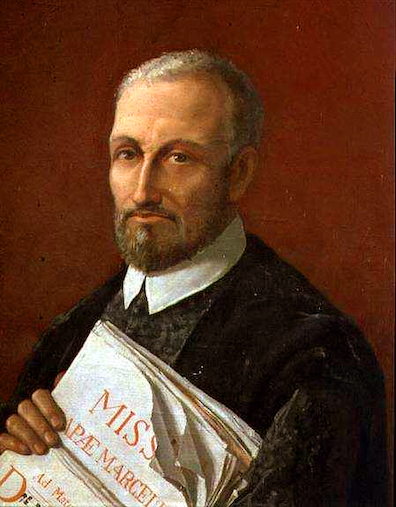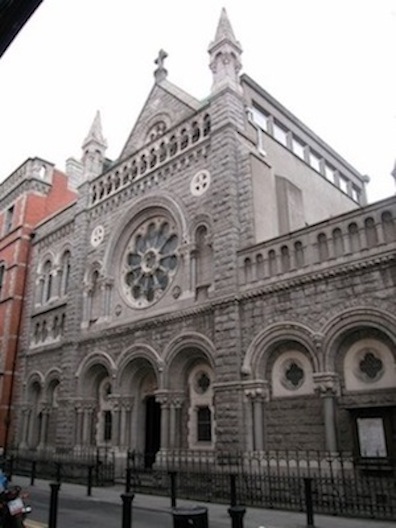In Telemachus Stephen thinks of the "mass for pope
Marcellus," pondering both the paradoxical achievement of the
music ("the voices blended, singing alone loud in
affirmation") and its religious significance ("and behind
their chant the vigilant angel of the church militant disarmed
and menaced her heresiarchs"). Musical tension between
multiplicity and unity, addressing a theological dispute about
heresy and orthodoxy, was an essential concern of Giovanni
Pierluigi da Palestrina when he composed this great work of
Renaissance polyphony in or around 1564. The music clearly
meant a lot to Joyce: in Lotus Eaters he has Bloom too
mention Palestrina after thinking, "Some of that old sacred
music is splendid" and "Those old popes were keen on music."
It seems likely that Stephen may be considering the work's
relevance to composing a masterpiece in his own realm of
literary art.
Palestrina's mass is one of the highest achievements of
Renaissance sacred music, as spiritually powerful as it is
musically exquisite. It also reflects an ideological struggle.
When Stephen imagines that, behind the voices of the singers,
the Archangel Michael
("the vigilant angel") stands menacing all
those who would endanger Christian verities—Gifford observes
that Michael was often invoked in Catholicism’s struggle
against Protestantism in the 16th century—he is recalling a
church debate about what is acceptable in religious music.
Medieval church music had begun with monophonic "chant";
only over the course of centuries did polyphony (vocal music
with multiple melodic lines intersecting to produce chords)
become popular. In its counter-Reformation efforts to
strengthen the church, the Council of Trent (1545-63) issued
decrees against "music in which anything lascivious or impure
was mixed," and its sterner members argued that only chant
should be allowed in churches.
Palestrina was a brilliant composer of polyphony, and his
music was utterly dependent on church patronage. When
Marcellus II died in 1555, his successor Paul IV immediately
dismissed Palestrina from papal employment. But Paul's death
in 1559 opened the holy see to Pius IV, who was more
sympathetic to polyphony. In 1564 Pius commissioned Palestrina
to compose a polyphonic mass that would answer all the
objections to such music. Judging by the esteem in which
Palestrina has been held by Italians ever since, he succeeded.
Giuseppe Verdi said of the composer, "He is the real king of
sacred music, and the Eternal Father of Italian music." In James
Joyce and the Making of Ulysses (1934), Joyce's friend
Frank Budgen records that "He was a great admirer of
Palestrina, and that not alone for Palestrina's musical
achievements. It was as something of a hero that he regarded
the great Italian. / 'In writing the Mass for Pope
Marcellus,' said Joyce, 'Palestrina did more than
surpass himself as a musician. With that great effort,
consciously made, he saved music for the Church" (182).
It is not primarily theological doctrine, then, that Michael
is defending against heresiarchs when choirs sing this mass,
but sacred music itself. The righteous archangel evokes
Palestrina’s having successfully defended polyphony as aesthetically
orthodox. The singers' voices are polyphonically diverse ("blended"
together), but they sing "alone loud in affirmation”"in
a kind of "chant," just as multiple voices join to make
a single haunting voice in Gregorian plainsong. Thus the Mass
for Pope Marcellus is artistically innovative but still
traditional, an intricately complex mixture of diverse
elements yet still radiantly "pure" enough to satisfy the
censors.
By the time he wrote Ulysses Joyce had begun to use
his discarded Catholic religion as "a
system of metaphors" (Richard Ellmann's phrase) for his
literary art. It is quite plausible to imagine that he heard
in Palestrina's mass something similar to what he was
attempting to do in his great novel: carry sanctified literary
traditions like Homeric epic and Shakespearean drama forward
into the confusing welter of contemporary existence, and
combine a kaleidoscopic multitude of subject matters and
styles in a single aesthetically harmonious whole. As Stephen
stands on the Sandycove rocks, swept up in the inspiring power
of Palestrina's music, he may well be thinking about how "his
own rare thoughts" may produce a work of comparable power.
Gifford and Seidman note that Edward Martyn helped to
generate enthusiasm for Palestrina and his Renaissance
contemporaries in 1890s Dublin, and the mass for pope
Marcellus was first performed at St. Teresa’s church in 1898.
It is likely that Joyce attended this performance: he loved
the lute songs of the English Renaissance, and in Penelope
Molly thinks of having sung in a concert in "St Teresas
hall Clarendon St."


